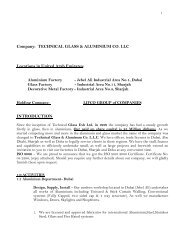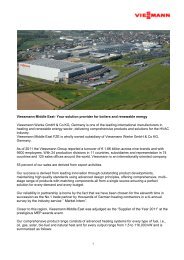Pearl Building Rating System - Estidama
Pearl Building Rating System - Estidama
Pearl Building Rating System - Estidama
Create successful ePaper yourself
Turn your PDF publications into a flip-book with our unique Google optimized e-Paper software.
RE-5: Peak Load Reduction<br />
Intent To reduce energy demand and consequent increased infrastructure requirements to<br />
cater for loads at peak use times through efficient building and services design and sitebased<br />
renewable energy generation.<br />
Credit<br />
Requirements<br />
Awarding Credit<br />
Points<br />
Credit<br />
Submission:<br />
Design <strong>Rating</strong><br />
Credit<br />
Submission:<br />
Construction<br />
<strong>Rating</strong><br />
Calculations and<br />
Methodology<br />
GENERAL<br />
Demonstrate the following:<br />
� 2 Credit Points: Peak electrical load is less than 80% greater than the project design<br />
annual average electrical load.<br />
� 4 Credit Points: Peak electrical load is less than 60% greater than the project design<br />
annual average electrical load.<br />
ADDITIONAL REQUIREMENT/CLARIFICATIONS<br />
None<br />
CREDIT POINTS REQUIREMENTS<br />
4<br />
(maximum)<br />
2<br />
4<br />
4<br />
(maximum)<br />
2<br />
4<br />
Design <strong>Rating</strong><br />
Demonstrate peak electrical load shall be less than 80% above<br />
annual average electrical load.<br />
Demonstrate peak electrical load shall be less than 60% above<br />
annual average electrical load.<br />
Construction <strong>Rating</strong><br />
Demonstrate peak electrical load is less than 80% above annual<br />
average electrical load.<br />
Demonstrate peak electrical load is less than 60% above annual<br />
average electrical load.<br />
� Graph from the dynamic energy simulation illustrating the annual electrical load<br />
profile of the proposed building, highlighting the peak and annual average<br />
electrical loads;<br />
� Calculations confirming the percentage increase in peak electrical load compared<br />
to the annual average electrical load; and<br />
� Narrative describing each of the major peak load reduction strategies, along with<br />
drawings, equipment data sheets/specifications as necessary to illustrate how and<br />
where the chosen measures are incorporated into the proposed building design.<br />
� Graph from the dynamic energy simulation illustrating the annual electrical load<br />
profile of the as-built building, highlighting the peak and annual average electrical<br />
loads;<br />
� Calculations confirming the percentage increase in peak electrical load compared<br />
to the annual average electrical load; and<br />
� Updated narrative describing each of the major peak load reduction strategies,<br />
along with as-built drawings, equipment data sheets/specifications as necessary to<br />
illustrate how and where the chosen measures are incorporated into the as-built<br />
building design.<br />
� The peak and annual average electrical load (MW) must be determined from the<br />
modeling results of the dynamic simulation undertaken as part of RE-R1 Minimum<br />
<strong>Pearl</strong> <strong>Building</strong> <strong>Rating</strong> <strong>System</strong>: Design & Construction, Version 1.0, April 2010 161 of 223







